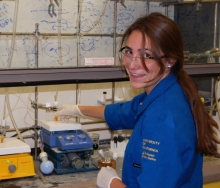
Major:
Mentor(s):
Faculty Sponsor(s):
Faculty Sponsor's Department(s):
Project Title:
Project Description:
Allylic systems are versatile substrates, as they can provide both the SN2 and SN2’ displacement products. More specifically, copper-catalyzed alkylations of allylic systems are especially useful, as the copper source and ligand can be fine-tuned to enhance the regio-, stereo-, and enantioselectivity of the alkylation. Leaving groups that have previously been investigated in copper-catalyzed allylic alkylations include halogens, carbamates, sulfonates, ethers, and phosphonates, however all of these moities are usually prepared from the corresponding alcohol, and require additional preparation and isolation prior to their use in displacement chemistry. A general method has been developed to perform allylic alkylations from allylic alcohols using an in situ formed tri-alkoxysilane as the leaving group. This one-pot procedure involves two steps; in the first, a silyl-ether is formed by copper catalyzed dehydrogenative silylation. In the second step, the copper catalyst is then used to perform the allylic alkylation with a Grignard reagent. A complete preference for the linear product was achieved using Diethoxymethylsilane (DEMS), 1,2 bis(diphenylphosphino)benzene (BDP) as the ligand, and Cu(OAc)2H2O as the copper source. These results demonstrate that by judicious choice of reagents synthetic sequences involving allylic alkylations can be streamlined, reducing waste, improving atom economy, and also opens the possibility of performing enantioselective chemistry on unactivated allylic alcohols.
